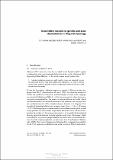Mixed effect models for genetic and areal dependencies in linguistic typology
Author(s)
Jaeger, T. Florian; Graff, Peter; Croft, William; Pontillo, Daniel
DownloadJaeger-2011-Mixed effect models.pdf (5.559Mb)
PUBLISHER_POLICY
Publisher Policy
Article is made available in accordance with the publisher's policy and may be subject to US copyright law. Please refer to the publisher's site for terms of use.
Terms of use
Metadata
Show full item recordAbstract
1. Introduction
1.1. Summary of Atkinson 2011
Atkinson (2011) sets out to test the so-called “serial founder model” against crosslinguistic data on phonological diversity. In his words (Atkinson 2011: Supporting Online Material: 3), the serial founder model predicts that
[. . . ] during population expansion, small founder groups are expected to carry
less phonemic diversity than their larger parent populations. A series of founder
events should produce a gradient of decreasing phonemic diversity with increasing
distance from the origin.
To test this hypothesis, Atkinson employs a sample of 504 non-extinct languages from WALS (Haspelmath et al. (eds.) 2008), for which the number of vowels, the number of consonants, and the number of tones in the language are annotated (Maddieson 2008a, b, c). For the main analysis, these three measures were standardized (i.e., the mean was subtracted from each value, which was then divided by the standard deviation of the measure) and averaged into one combined measure of the total phonological diversity of a language. This normalized phonological diversity measure ranges from −1.19 to 1.68 (mean =0.02). Each language is also annotated for its coordinates on the globe as well as it population size (the number of speakers).
Date issued
2011-11Department
Massachusetts Institute of Technology. Department of Linguistics and PhilosophyJournal
Linguistic Typology
Publisher
Walter de Gruyter
Citation
Jaeger, T. Florian, Peter Graff, William Croft, and Daniel Pontillo. “Mixed Effect Models for Genetic and Areal Dependencies in Linguistic Typology.” Linguistic Typology 15, no. 2 (January 2011). © 2011 Walter de Gruyter.
Version: Final published version
ISSN
1430-0532
1613-415X